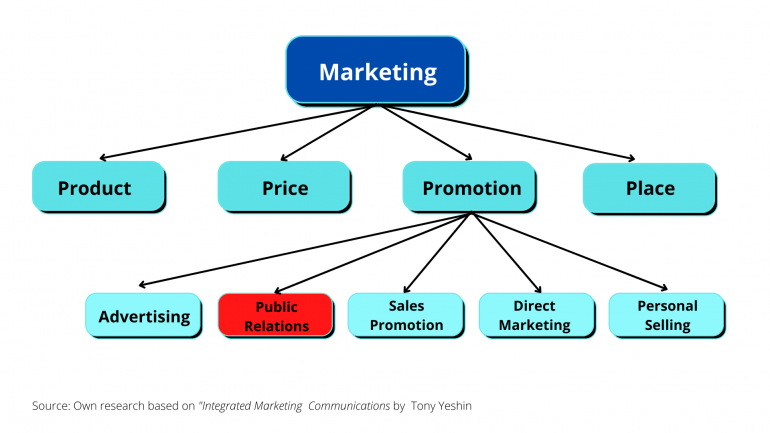How often do you see Tesla, Apple or Amazon ads? Not too often, I bet. Since these largest companies in the world know the power of public relations, it’s very rare, if ever, to see their advertisements anywhere, but we hear about them mainly due to their public relations activities. As more and more executives realize that people have started to avoid paid ads, companies are increasingly dropping advertising and starting to rely on public relations to get their message across and appear credible.
Unfortunately, many executives still have little idea of what public relations is, what PR means, and how important and effective it can be for their businesses and, ultimately, companies’ bottom line. So what is PR and why is it important to business?
Public Relations is one of the most effective strategies for building a lasting reputation and brand awareness in a company, and for increasing trust without breaking the bank. By keeping their ear to the ground with the help of public relations departments, companies can actively shape their image in the eyes of the public and maintain steady and favorable relationships with customers, investors, or employees. Firms that have figured out how to make public relations work to their advantage are more likely to stay on top of their public reputation, which will ultimately lead to higher revenues.

Table of Contents
- What is Public Relations?
- Public Relations, Corporate Communications, or Maybe Just Communications?
- What Are the Objectives of Public Relations?
- What Exactly Does PR Do?
- Major Public Relations Tools & Tactics
- Public Relations vs Marketing
- The Difference Between PR and Advertising
- The Impact of Public Relations
- Towards an Integrated Approach
What is Public Relations?
Public relations really makes the difference between a company's success and failure by influencing its reputation and relationships with the public. As you might expect, it is a popular but complex and widespread field that is unfortunately often misperceived and misunderstood as well. In fact, the multifaceted nature of public relations left room for many interpretations, leading to a myriad of definitions.
In today’s world, public relations is widely perceived as the art of persuasion aimed at prevailing on your audience to purchase your product, endorse your idea, support your cause, or acknowledge your accomplishments. While this definition sounds like it could be used to describe advertising, public relations differs drastically from it, as public relations is about earned media, whereas advertising is about paid media.
The Public Relations Society of America (PRSA) defines public relations as “a strategic communication process that builds mutually beneficial relationships between organizations and their publics.” While another approach to public relations was presented by Ivy Lee, also known as the Father of Public Relations, who considered public relations as “the art of relating one's ideas and purposes to the public, or the activity of explaining one group within society to another.” Even though it sounds fairly complicated, it highlights that the critical element of successful public relations is effective communication with the target audience.
Edward Bernays, a pioneer in the field of public relations, wrote, "The three main elements of public relations are practically as old as society: informing people, persuading people, or integrating people with people. Of course, the means and methods of accomplishing these ends have changed as society has changed."
The critical purpose of public relations is to frame and shape the public perception of a company by engaging, impacting, and creating relationships with key partners across multiple platforms. Furthermore, another important function of public relations is to foresee, scrutinize, and interpret public opinions, attitudes, and issues that might have an impact, either positive or negative, on the organization's operations, strategies, and plans. To keep the image of the organization under control, public relations departments work closely with top management to counsel on critical decisions, courses of action, and announcements, including press releases on crisis communication, to prevent any negative public ramifications.
The practice of public relations also includes protecting the reputation of an organization by building, conducting, and assessing programs of action and communications that inform the public and align with the organization's goals.
To keep the organization’s image under control, public relations departments collaborate closely with top executives, counseling them with regard to critical decisions, courses of action, and announcements, including crisis communication press releases, to prevent any negative public ramifications.
Public relations is an important part of any business, organization, or institution, whether recognized or not, since it is inevitable to not create a multi-layered network of internal and external relationships. As a matter of fact, public relations is about building that elaborate web of relationships.
Back to topPublic Relations, Corporate Communications, or Maybe Just Communications?
Generally, public relations is viewed as an umbrella term worldwide that is used mainly by nonprofit trade associations, nonprofit organizations, or nonprofit foundations, for instance, the Public Relations Society of America (PRSA), the International Public Relations Association (IPRA), or the Institute for Public Relations. All of them have the term ‘public relations’ in their names, however, the corporate world widely uses other terms instead of public relations.
After scrutinizing numerous job posts at the highest-traffic job search engine in the United States, Indeed, it can be clearly noticed that companies prefer to use different terms in their job titles in place of ‘public relations’ such as corporate communications, communications, public affairs, publicity, brand publicity, strategic communications, community relations, or public policy. So what is the reason professionals tend to avoid using the term ‘public relations’ to substitute it with some others?
Namely, it is argued that the term, corporate communications along with its many variations, is better-suited to the business world, encompassing not just PR concerns, but also social issues, geopolitical challenges, risk prevention, human capital challenges, creative, and content marketing, social justice, and many others. Moreover, there is one more reason the world of business prefers some other terms, skirting the term ‘public relations’ itself.
It is believed that such terms as corporate communications or communications not only get away from the negative stereotypes associated with the term ‘public relations’ but also convey a more positive impression and generally sound more notable.
Back to topWhat Are the Objectives of Public Relations?
Public relations is a very useful communication tool that organizations use to build positive relations with their various publics, including consumers, the media, government organizations, investors, and their communities in order to promote products, services, activities, people, places, ideas, and even nations.
The main goals of public relations are to:
- Increase credibility by providing third-party endorsements through magazines, newspapers, web portals, niche blogs, radio, and television;
- Boost sales and generating sales leads to facilitate the sales process by organizing the publication of articles in the trade press about new products and services;
- Build brand awareness;
- Provide support and focus on those issues which are important to the company, such as newsworthy events, actions, or campaigns;
- Build the reputation as a thought leader, authority, and expert within a particular field, as well as a credible source of information about a given industry;
- Encourage external discussions to explain some controversial issues;
- Promote particular products, services, and brands;
- Communicate and clarify the company’s policy, mission, vision, and values to the public.
- Create new opportunities by discovering perspectives in new markets.
- Make information available to the media to bring attention to a product, service, action, or campaign;
- Assist in changing public perception of an organization;
- Influence existing opinions to be more favorable to the organization;
- Lobby for the benefit of the company by developing relationships with public officials and legislators to influence legislation;
- Establish relationships with local or national communities;
- Foster connections with investors, shareholders, and other financial industry participants;
- Collaborate with donors and members of nonprofit organizations in order to secure funds and volunteers.
As Philip Kotler, S. C. Johnson & Son Distinguished Professor of International Marketing at the Kellogg School of Management, Northwestern University and author of Marketing Management put it in the Harvard Business Review article, titled “Megamarketing,” “Public relations takes longer to cultivate, but when energized, it can help pull the company into the market.”
Back to topWhat Exactly Does PR Do?
To know exactly what public relations does and what falls under the PR umbrella, it’s necessary to describe the various functions that public relations encompasses, such as:
Media Relations
Media relations is all about working with the media by building relationships with editors and reporters with the goal of garnering favorable press coverage of your company or your product. Essentially, this involves attracting the media attention to your company by distributing press releases, scheduling interviews, giving press conferences, cold pitching to editors, and connecting with journalists on social media.
Strategic PR Counseling
The goal of PR counseling is to assist top executives in developing communications objectives, strategies, and tactics targeted at meeting the companies’ objectives by identifying and addressing both internal and external audiences, as well as providing advice regarding communication, relationships, and policies. PR counseling is acknowledged as an ongoing process that evaluates different issues and opportunities that organizations face occasionally, so that specific steps can be taken in order to move forward.
Investor Relations
Investor Relations (IR) departments are typically established before companies go public. Their main purpose is to showcase the company as an investment opportunity by providing investors, investment analysts, government organizations, shareholders, and the financial community with accurate information on the company’s affairs in the form of financial statements, financial statistics, products, and services as well as an outline of its organization structure to help them undertake informed investment decisions.
Government Relations
Government relations entails influencing public policy at the local, state, and federal level, as well as globally by convincing public officials to maintain or alter policies, typically ones that will benefit your organization and suit its needs. In fact, government relations experts can be hired to establish and later leverage connections with key decision-makers in order to drive forward the organization’s agenda.
Public Affairs
Public affairs deals comprehensively with public policy issues, including but not limited to government relations or media relations by assisting companies in interacting with legislators, but also various interest groups and the media to find solutions to problems. The role of public affairs professionals is to serve as a conduit between the organization and its stakeholders, such as the media, government, and community.
Crisis Management
As crises arising from a variety of issues, such as defective products or employee misconduct, can seriously damage a company's reputation or even threaten its existence, the crisis management team is a critical component of any public relations strategy. Experienced crisis management specialists are able to spin the issue very quickly because they have a set of best practices and lessons at their disposal. Since they are experts in every media channel, they are able to identify which issues require a press conference and which can be addressed with a simple tweet.
Customer Relations
Customer relations refers to the long-term approach businesses use to connect and interact with customers in order to establish lasting relationships not only by helping them with day-to-day inquiries but also by developing long-term policies that enhance customers’ future experiences to benefit overall customers’ journey over the long term. When customer relations are handled correctly, positive outcomes can occur, such as increased customer retention, increased customer lifetime value (CLV), and stronger customer relationships.
Employee Relations
The main goal of employee relations, which is also called internal PR, is to ensure that employees are productive, loyal, motivated, and fulfilled and get along with each other, but also enhance the company's culture by creating and maintaining a positive perception of the company. Employee relations professionals assist executives in building positive relationships with their employees by providing ongoing support for employees, staging employee events, creating internal newsletters, resolving disputes, or handling grievances.
Community Relations
Community relations is all about developing a two-way relationship with the community in which organizations operate by cultivating their positive image and fostering goodwill in order to win potential customers and help the community prosper as a whole. To build and strengthen the relationships with the communities, companies need to identify an essential need and find a solution to fix it by providing donations to the local cause, sponsoring local events, or volunteering at a local charity.
Back to topMajor Public Relations Tools & Tactics
When public relations practitioners need to communicate information to the media, they can choose from several PR tools, including:
- Advertorials
- Bylined articles
- Feature articles
- Guest posts
- Press releases
- Media advisories
- News briefs
- Letters to the editor
- Newsletters
- Speaking engagements
-
Brochures and catalogues
-
PR stunts
- Social media
- Influencers
- Business events
- FAM trips (Familiarization trips)
- Press conferences
-
Sponsorships or partnerships
Public Relations vs Marketing
So what is the difference between PR and marketing?
To understand the main differences between public relations and marketing, let’s start by specifying what marketing actually is. The American Marketing Association defines marketing as “the activity, set of institutions, and processes for creating, communicating, delivering, and exchanging offerings that have value for customers, clients, partners, and society at large.” In fact, according to the traditional viewing introduced in the 1950s, marketing is a mix of four components such as product, price, place, and promotion, creating the marketing mix.
One of the elements of the marketing mix is promotion, also known as communication, which consists of five main marketing communications tools, including advertising, public relations, sales promotion, direct marketing, and personal selling, also referred to as the marketing communications mix. As presented, marketing is an umbrella term encompassing various marketing promotion tools, including but not limited to public relations, designed to communicate with a target audience.
As businesses need to engage customers, build their brand, and increase sales, they need a solid marketing strategy with promotion as an essential part, which is not a single tool but a mix of several tools hidden under the concept of integrated marketing communications.
By coordinating all elements, including public relations, promotion supports marketing objectives in building clear and consistent goodwill, and value of the company, conveying an overall positive message primarily about the mission, vision and values of the organization, but also about products.
Back to topThe Difference Between PR and Advertising
Since many people confuse public relations with advertising, it is necessary to point out the differences between them and dispel all doubts. While both public relations and advertising use the mass media to spread the message, the format and context they use are different.
Public relations relies on relations with journalists and editors who always have the last word on whether to put the material submitted by PR departments in the magazine, newspaper, or website or to reject it. Whereas advertising is about preparing the ad over which you have full control and buying space or broadcast time to show it in the media-controlling where, how, and when exactly the advertisement will be run. The former is called earned media, while the latter is known as paid media.
Due to the fact that public relations messages are published in the editorial section of a newspaper, magazine, or website rather than the 'paid media' section, they tend to generate higher credibility since they were earned and verified by an independent third party instead of purchased.
The key difference between public relations and advertising is that public relations relies on a variety of communication tools including press releases, brochures, feature articles, slide shows, special events, speeches, reportage, and so on, while most of the advertising utilizes paid mass media outlets.
Public relations and advertising are also vastly different in terms of price. PR firms charge monthly retainer fees or can be hired on a per-project basis, which seems to be less costly compared to advertising, which is typically very expensive.
In general, advertising is often seen as a specialized marketing communication function, while public relations tends to be viewed in a broader sense, affecting many areas of the organization, ranging from employee morale to local community donations.
The first female advertising executive in the US, Helen Woodward, said “advertising is what you pay for, publicity is what you pray for,” which is self-explanatory. In other words, PR is earned media whereas advertising is paid media.
According to Al and Laura Ries, authors of The Fall of Advertising and The Rise of PR, “We’re beginning to see research that supports the superiority of PR over advertising to launch a brand.”
Back to topThe Impact of Public Relations
As public relations is based on earned media attention, not paid media attention, its impact is much bigger than other promotional options. In the minds of the target group, the message disseminated by public relations professionals is much more credible and valuable than any other advertisement since it capitalizes on the third party endorsement in the form of media.
Since audiences believe the media are independent sources that provide unbiased coverage where decisions to include or not a specific company name in an article are merit-based, not payment-based, even a brief press mention generates amazing publicity, high credibility, and trust. Provided it is positive, of course.
For instance, an in-depth and substantive interview with the CEO in the leadership section in a magazine, trade press or web portal usually has a much greater influence on readers, and ultimately on sales results, than a full-page advertisement because readers view the media as presenting an objective and impartial opinion.
Moreover, the reach of the impact that public relations generates through one medium could be even more extended, as depending on the story, the message may become viral and be intercepted by other media that could spread it even further, increasing its reach more and more.
The impact of public relations may seem to be even higher, especially when we take into account the cost, which is significantly lower in the case of public relations compared to advertising. That is not to say that public relations is not expensive, it definitely might be, especially when it is handled by a PR agency or PR professionals. However, the return on promotional expenditure on public relations can be quite high compared to other forms of promotion, most notably advertising, which is often exorbitantly expensive but, in many cases, less persuasive.
However, the return on promotional expenditure on public relations can be quite high and tends to be quite cost-effective and profitable compared to the other forms of promotions, particularly advertising, which is often exorbitantly expensive, but in many cases less persuasive.
Back to topTowards an Integrated Approach
After recognizing the clear differences between advertising and public relations, there is growing awareness that an organization's goals can best be achieved through an integrated approach, which is known as integrated marketing communications (IMC) or integrated communications.
According to Don Schulz, Stanley Tannenbaum, and Robert Lauterborn, authors of Integrated Marketing Communications, “It is no longer sufficient to be an expert in a single area of communications, such as advertising or public relations. For the future, those charged with the responsibility for the development and implementation of marketing communications campaigns will need to achieve a comprehensive understanding of each of the component parts.”
The new concept of marketing communication recognizes the added value of a comprehensive perspective that values each of the four elements of marketing equally, including advertising, public relations, direct response, and sales promotion, bringing together these disciplines to ensure clarity, coherence, and maximum impact of communication.
Conclusion
The Internet and social media have transformed our world into a "global village" where virtually anyone can be reached in seconds, greatly increasing the impact of communication and public relations, which must therefore be handled with great care.
As public relations is an extremely effective communication tool, it may have a great influence on public awareness, creating impressive results, usually at a lower cost than advertising. Even though public relations still makes up only a small percentage of firms' marketing budgets, it is becoming an increasingly important tool for building brands.
Since the lines between advertising and PR are blurring more and more in the digital age of mobile devices and social media, it is very rare for organizations to utilize the tools of public relations in isolation from other forms of marketing communication leading to a more integrated marketing approach.
Back to top

Like our content? Follow BUSINESS POWERHOUSE on LinkedIn, Twitter, Facebook, Instagram, and Pinterest to stay up-to-date on our latest articles.
Sources:
"Integrated Marketing Communications" by Don Schulz, Stanley Tannenbaum, and Robert Lauterborn
"Marketing Management" by Philip Kotler, Kevin Keller
"Public Relations: Strategies and Tactics" by Dennis L. Wilcox, Glen T. Cameron, Bryan H. Reber
Author: Justine Ilone Siporski is the founder, CEO and Editor-in-Chief of BUSINESS POWERHOUSE, the founder and CEO of LANGUAGE EMPIRE, coach, trainer, investor and columnist dedicated to the advancement of entrepreneurs, investors and the C-suite (CMOs, CEOs, CFOs, CIOs). Her key mission is to support leaders, business professionals and investors in achieving their highest potential, making the right business and investing decisions, and expanding their horizons.







Comments